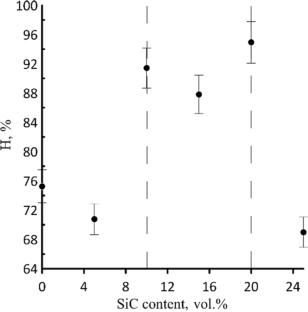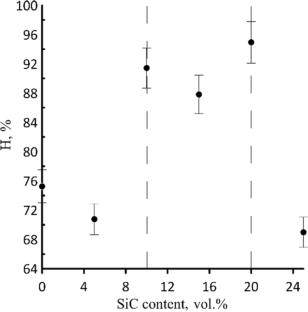ZrB2-SiC陶瓷成分对缺陷自愈的影响
IF 0.4
4区 物理与天体物理
Q4 PHYSICS, MULTIDISCIPLINARY
引用次数: 0
摘要
ZrB2-SiC复合陶瓷的高热阻使其成为制造温度超过2000 °C的热防护结构的有希望的候选者。ZrB2-SiC复合陶瓷的一个显著优点是在循环温度作用下缺陷能自愈。本文研究了ZrB2-SiC复合陶瓷在1200、1400和1600 ℃退火下表面人工缺陷的自愈。结果表明,在1600° °C退火后,自愈过程最有效。发现复合陶瓷中SiC含量的增加和温度的升高使缺陷自愈能力增强。本文章由计算机程序翻译,如有差异,请以英文原文为准。


Effect of ZrB2-SiC ceramics composition on defect self-healing
High thermal resistance of ZrB2–SiC composite ceramics makes it a promising candidate for creating heat-protective structures operating at temperatures exceeding 2000 °C. A significant advantage of ZrB2–SiC composite ceramics is self-healing of defects under cyclic temperature effects. The paper investigates self-healing of artificial defects on the surface of ZrB2–SiC composite ceramics at 1200, 1400 and 1600 °C annealing. It is shown that the most efficient self-healing process occurs after 1600 °C annealing. It is found that defect self-healing increases due to the higher temperature and increased SiC content in composite ceramics.
求助全文
通过发布文献求助,成功后即可免费获取论文全文。
去求助
来源期刊

Russian Physics Journal
PHYSICS, MULTIDISCIPLINARY-
CiteScore
1.00
自引率
50.00%
发文量
208
审稿时长
3-6 weeks
期刊介绍:
Russian Physics Journal covers the broad spectrum of specialized research in applied physics, with emphasis on work with practical applications in solid-state physics, optics, and magnetism. Particularly interesting results are reported in connection with: electroluminescence and crystal phospors; semiconductors; phase transformations in solids; superconductivity; properties of thin films; and magnetomechanical phenomena.
 求助内容:
求助内容: 应助结果提醒方式:
应助结果提醒方式:


